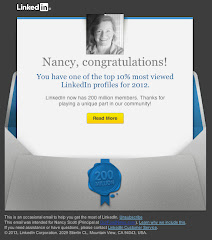On January 6, I attended a talk by Stan Rapp, who co-founded Rapp Collins Worldwide and is now chairman of
Engauge, the Atlanta-based full-service marketing agency with expertise in digital and interactive marketing. (Disclosure: I'm awed -- and probably swayed -- by the fact that Stan, courageously and with pleas from
Morris Dees, managed the
George McGovern presidential campaign).
Be that as it may, Stan's informal dinner presentation on Thursday made a strong case that, going forward, the merger of direct marketing and digital lies at the core of what marketing will be. Stan calls that intersection "iDirect."
In his view (and that of many visionary industry observers), traditional,
Mad Men advertising -- which, unlike direct marketing, is a) non-measurable and b) has been dominated by what Stan calls the Media/Agency/
Nielsen Complex -- has wasted some $2 trillion in the 20th century. In short, with no engagement, no brand-building, and no Internet connection, Stan describes 60 percent of print media advertising as “garbage.” At the presentation, he invited the professors in attendance to take last week’s edition of
Newsweek and challenge their students to figure out how – by any measure (because there is none) – the ad dollars aren’t “wasted.”
Pepsi's defection from Super Bowl ads to online is cited by many as further confirmation of the trend away from traditional advertising.
Stan noted that “iDirect is the future of marketing. It is the growth engine at the confluence of Digital and Direct that enables customer engagement to drive a better ROI than ever before.”
Stan acknowledges that, while iDirect is the future, nobody is precisely sure what it will look like, but the
perfect storm would appear to involve merging marketing across all channels, from online to offline, together in multi-variate, measurable touch points: mail, email, web, mobile, social, CRM, etc. This isn't your Dad's "integrated marketing," though. That's old news.
If a
January 8 post by Samuel Axon on Mashable is correct, the billion dollar gate from
Avatar is probably a solid example of the social side of iDirect at work. Now how do we take this outreach to the
remainder of marketing?
1. Are we talking about behemoth iDirect agencies, bigger than the Department of Defense, trying to do every single marketing thing that a company needs – and then, in real time, running the results, measuring, reacting, reframing? I mean that hasn’t worked out too well for DOD, has it?
2. Or are we talking about simply applying the lessons of direct marketing – namely, if you can’t measure it, don’t do it – to every imaginable digital effort like email, web, social media, and those yet conceived?
3. (My Choice!) Or are we talking about some evolving form of digital application that can bring the message to one place in the customers’ hands. I think that’s the one.
Case in Point One: My friend’s love affair with his new
Palm Pre. I haven’t gotten beyond my Blackberry (which, frankly, I hate), so I’m no expert in smart-phoning. But my friend is and he's literally spent weeks fixing this gadget to the point where he can now carry his office -- even his
life -- in his pocket. He checks email, of course.. but also retreives soccer scores, listens to podcasts, figures out where the restaurant is, reads movie reivews, follows blogs and Twitter, and gets what
ever he wants on uStream. Last night, he announced with incredible excitement that the Pre has an app for his new
Google Voice! This allows him – in some magical twist of technology – to talk for free, leaving Sprint pretty much out of the equation (extra points for screwing Sprint). The point is that maybe this is what we’re talking about when we keep saying that customers will drive the bus. This is
not about what
marketers will do, say, or contrive: This will be about what
customers will
choose to do. We won't be able to reach them unless they somehow allow that. Bottomline: Likely the contemporary marketer's job is to realize this difference and -- somehow -- respond. Very tricky.
Case in Point Two Makes the Case: In an energetic Q&A following Stan's remarks, one participant observed that, to the upcoming generation of iDirect users, "i" had an even more centric meaning -- as in "ego-centric." The commentator said, "To my 17-year old son, "the 'i' stands for 'I' -- as in, I get to chose the tunes I listen to, the video I watch, who I talk to, who my friends are." Me.
So, yeah… looks like our new job is going to be finding out where the customer is hanging out, nailing (not guessing) who might be interested in what, giving the customer a way to get back to us, measuring the reaction, re-evaluating (in real time, if possible), and then starting all over again. Technology can do it, but we have to dream it.
-- scrubbed by Marketing Brillo
Postscript: With Tim Suther, senior vice president, Global Multichannel Marketing Services of Acxiom Corporation, Stan co-chairs The DMA’s new
iDirect Leadership Committee, whose mission it is to “usher in the next era for marketing, based on a new and emerging set of customer-focused actions and processes that can be powered by advanced data systems.” While a lot of what The DMA does has been less than relevant for quite awhile, this committee should be a good place to start.


